Enterprise Resource Planning System Journey Analysis
VerifiedAdded on 2022/11/25
|14
|3685
|369
Report
AI Summary
This research paper provides a comprehensive overview of Enterprise Resource Planning (ERP) systems, focusing on the various phases involved in the implementation process. The report begins with the discovery and planning stage, emphasizing the importance of identifying business requirements and selecting a project team. It then delves into the design, development, testing, and deployment stages, highlighting the key activities and benefits associated with each phase. The paper also examines the critical role of ongoing support, including help desk services, additional training, and system upgrades. Furthermore, the report explores the challenges faced during ERP implementation and provides relevant case studies, such as the failures of Hershey's ERP implementation, to illustrate the complexities of the process. The paper concludes by emphasizing the continuous nature of the ERP journey and the importance of documentation, scalability, and continuous improvement to ensure system quality and performance. The report also references the importance of final documentation, help desk and on-site support, additional training, scalability and upgrades, and continued improvement for a successful ERP implementation.

Enterprise Resource Planning Systems
Your name
School-Affiliated
Your name
School-Affiliated
Paraphrase This Document
Need a fresh take? Get an instant paraphrase of this document with our AI Paraphraser
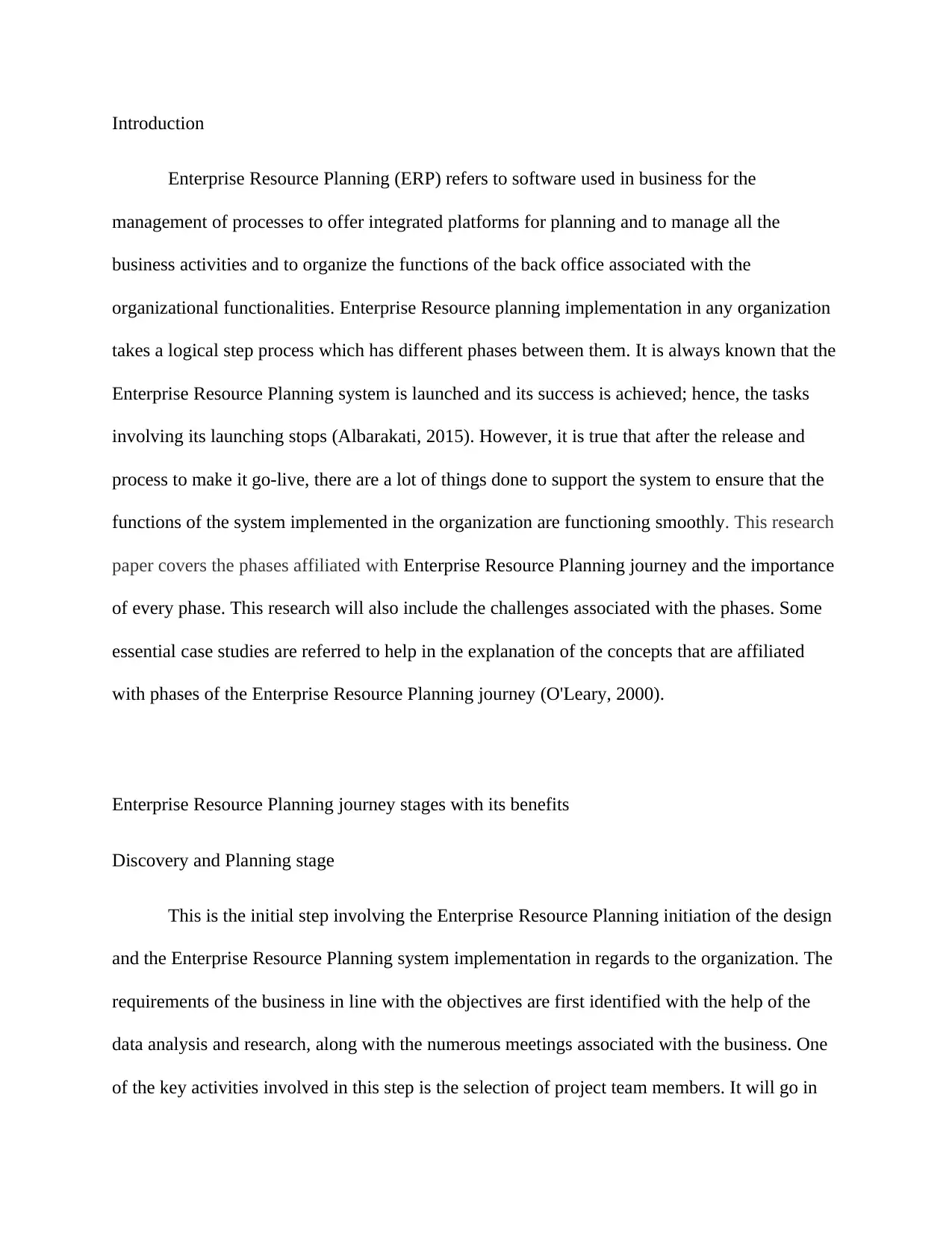
Introduction
Enterprise Resource Planning (ERP) refers to software used in business for the
management of processes to offer integrated platforms for planning and to manage all the
business activities and to organize the functions of the back office associated with the
organizational functionalities. Enterprise Resource planning implementation in any organization
takes a logical step process which has different phases between them. It is always known that the
Enterprise Resource Planning system is launched and its success is achieved; hence, the tasks
involving its launching stops (Albarakati, 2015). However, it is true that after the release and
process to make it go-live, there are a lot of things done to support the system to ensure that the
functions of the system implemented in the organization are functioning smoothly. This research
paper covers the phases affiliated with Enterprise Resource Planning journey and the importance
of every phase. This research will also include the challenges associated with the phases. Some
essential case studies are referred to help in the explanation of the concepts that are affiliated
with phases of the Enterprise Resource Planning journey (O'Leary, 2000).
Enterprise Resource Planning journey stages with its benefits
Discovery and Planning stage
This is the initial step involving the Enterprise Resource Planning initiation of the design
and the Enterprise Resource Planning system implementation in regards to the organization. The
requirements of the business in line with the objectives are first identified with the help of the
data analysis and research, along with the numerous meetings associated with the business. One
of the key activities involved in this step is the selection of project team members. It will go in
Enterprise Resource Planning (ERP) refers to software used in business for the
management of processes to offer integrated platforms for planning and to manage all the
business activities and to organize the functions of the back office associated with the
organizational functionalities. Enterprise Resource planning implementation in any organization
takes a logical step process which has different phases between them. It is always known that the
Enterprise Resource Planning system is launched and its success is achieved; hence, the tasks
involving its launching stops (Albarakati, 2015). However, it is true that after the release and
process to make it go-live, there are a lot of things done to support the system to ensure that the
functions of the system implemented in the organization are functioning smoothly. This research
paper covers the phases affiliated with Enterprise Resource Planning journey and the importance
of every phase. This research will also include the challenges associated with the phases. Some
essential case studies are referred to help in the explanation of the concepts that are affiliated
with phases of the Enterprise Resource Planning journey (O'Leary, 2000).
Enterprise Resource Planning journey stages with its benefits
Discovery and Planning stage
This is the initial step involving the Enterprise Resource Planning initiation of the design
and the Enterprise Resource Planning system implementation in regards to the organization. The
requirements of the business in line with the objectives are first identified with the help of the
data analysis and research, along with the numerous meetings associated with the business. One
of the key activities involved in this step is the selection of project team members. It will go in
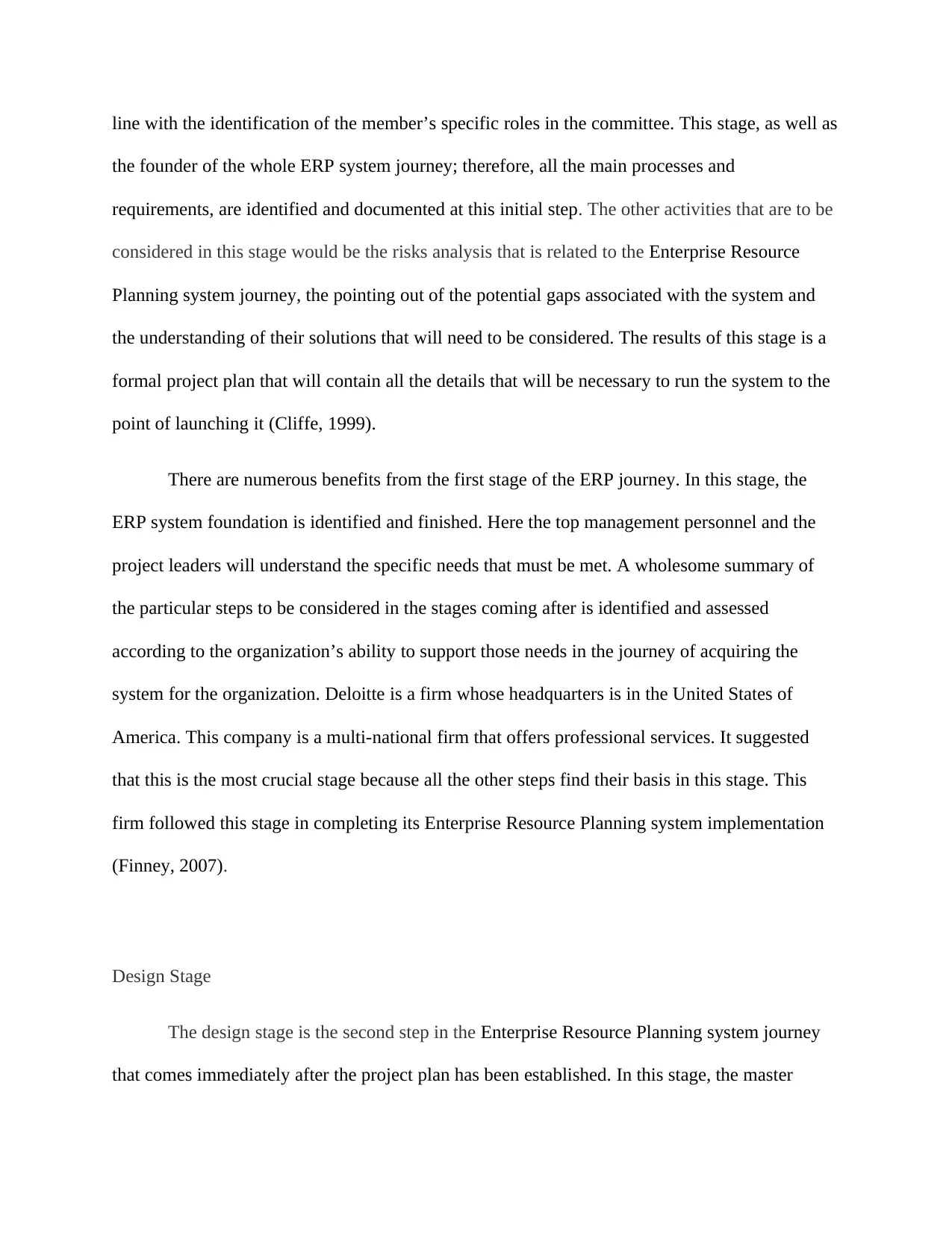
line with the identification of the member’s specific roles in the committee. This stage, as well as
the founder of the whole ERP system journey; therefore, all the main processes and
requirements, are identified and documented at this initial step. The other activities that are to be
considered in this stage would be the risks analysis that is related to the Enterprise Resource
Planning system journey, the pointing out of the potential gaps associated with the system and
the understanding of their solutions that will need to be considered. The results of this stage is a
formal project plan that will contain all the details that will be necessary to run the system to the
point of launching it (Cliffe, 1999).
There are numerous benefits from the first stage of the ERP journey. In this stage, the
ERP system foundation is identified and finished. Here the top management personnel and the
project leaders will understand the specific needs that must be met. A wholesome summary of
the particular steps to be considered in the stages coming after is identified and assessed
according to the organization’s ability to support those needs in the journey of acquiring the
system for the organization. Deloitte is a firm whose headquarters is in the United States of
America. This company is a multi-national firm that offers professional services. It suggested
that this is the most crucial stage because all the other steps find their basis in this stage. This
firm followed this stage in completing its Enterprise Resource Planning system implementation
(Finney, 2007).
Design Stage
The design stage is the second step in the Enterprise Resource Planning system journey
that comes immediately after the project plan has been established. In this stage, the master
the founder of the whole ERP system journey; therefore, all the main processes and
requirements, are identified and documented at this initial step. The other activities that are to be
considered in this stage would be the risks analysis that is related to the Enterprise Resource
Planning system journey, the pointing out of the potential gaps associated with the system and
the understanding of their solutions that will need to be considered. The results of this stage is a
formal project plan that will contain all the details that will be necessary to run the system to the
point of launching it (Cliffe, 1999).
There are numerous benefits from the first stage of the ERP journey. In this stage, the
ERP system foundation is identified and finished. Here the top management personnel and the
project leaders will understand the specific needs that must be met. A wholesome summary of
the particular steps to be considered in the stages coming after is identified and assessed
according to the organization’s ability to support those needs in the journey of acquiring the
system for the organization. Deloitte is a firm whose headquarters is in the United States of
America. This company is a multi-national firm that offers professional services. It suggested
that this is the most crucial stage because all the other steps find their basis in this stage. This
firm followed this stage in completing its Enterprise Resource Planning system implementation
(Finney, 2007).
Design Stage
The design stage is the second step in the Enterprise Resource Planning system journey
that comes immediately after the project plan has been established. In this stage, the master
⊘ This is a preview!⊘
Do you want full access?
Subscribe today to unlock all pages.

Trusted by 1+ million students worldwide
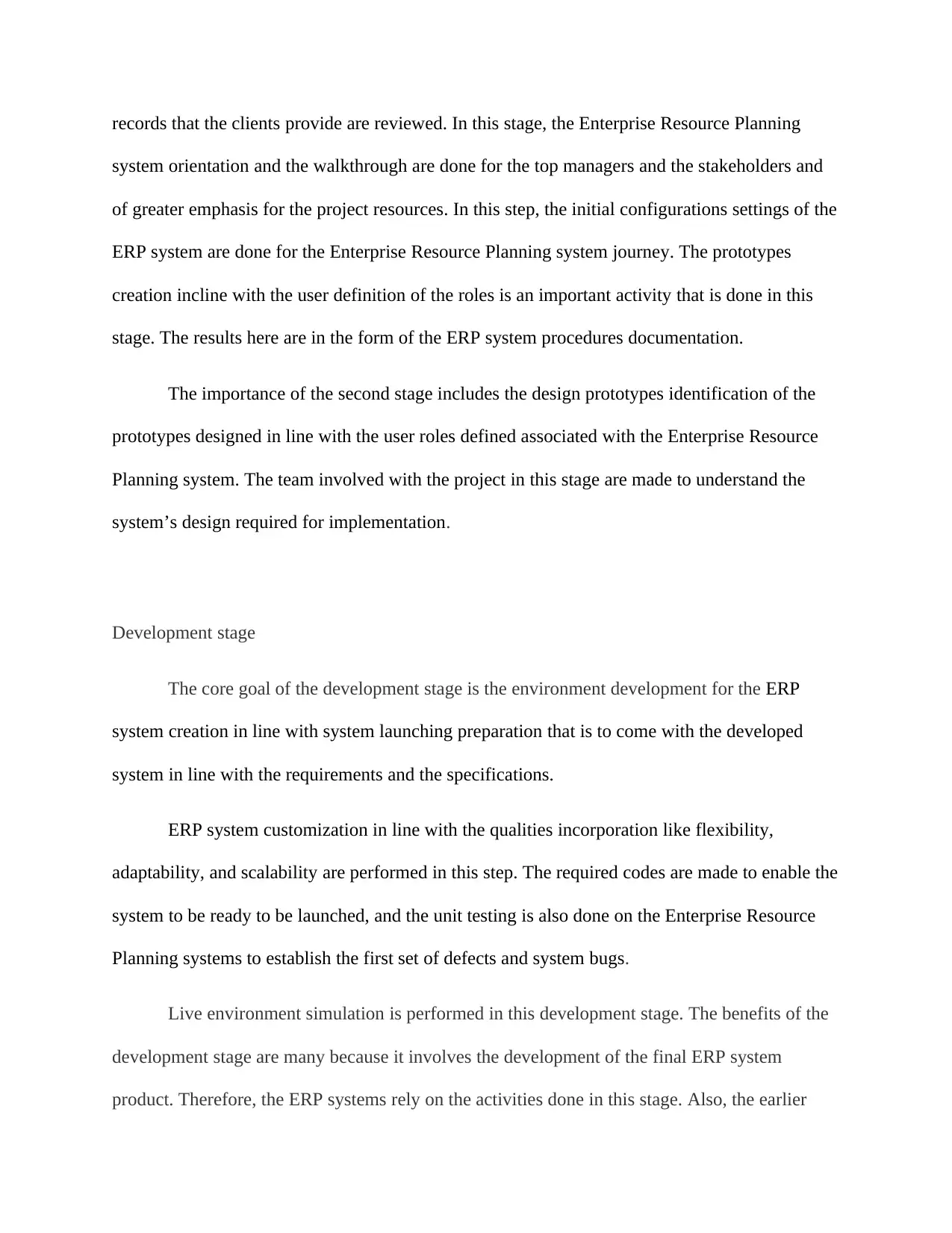
records that the clients provide are reviewed. In this stage, the Enterprise Resource Planning
system orientation and the walkthrough are done for the top managers and the stakeholders and
of greater emphasis for the project resources. In this step, the initial configurations settings of the
ERP system are done for the Enterprise Resource Planning system journey. The prototypes
creation incline with the user definition of the roles is an important activity that is done in this
stage. The results here are in the form of the ERP system procedures documentation.
The importance of the second stage includes the design prototypes identification of the
prototypes designed in line with the user roles defined associated with the Enterprise Resource
Planning system. The team involved with the project in this stage are made to understand the
system’s design required for implementation.
Development stage
The core goal of the development stage is the environment development for the ERP
system creation in line with system launching preparation that is to come with the developed
system in line with the requirements and the specifications.
ERP system customization in line with the qualities incorporation like flexibility,
adaptability, and scalability are performed in this step. The required codes are made to enable the
system to be ready to be launched, and the unit testing is also done on the Enterprise Resource
Planning systems to establish the first set of defects and system bugs.
Live environment simulation is performed in this development stage. The benefits of the
development stage are many because it involves the development of the final ERP system
product. Therefore, the ERP systems rely on the activities done in this stage. Also, the earlier
system orientation and the walkthrough are done for the top managers and the stakeholders and
of greater emphasis for the project resources. In this step, the initial configurations settings of the
ERP system are done for the Enterprise Resource Planning system journey. The prototypes
creation incline with the user definition of the roles is an important activity that is done in this
stage. The results here are in the form of the ERP system procedures documentation.
The importance of the second stage includes the design prototypes identification of the
prototypes designed in line with the user roles defined associated with the Enterprise Resource
Planning system. The team involved with the project in this stage are made to understand the
system’s design required for implementation.
Development stage
The core goal of the development stage is the environment development for the ERP
system creation in line with system launching preparation that is to come with the developed
system in line with the requirements and the specifications.
ERP system customization in line with the qualities incorporation like flexibility,
adaptability, and scalability are performed in this step. The required codes are made to enable the
system to be ready to be launched, and the unit testing is also done on the Enterprise Resource
Planning systems to establish the first set of defects and system bugs.
Live environment simulation is performed in this development stage. The benefits of the
development stage are many because it involves the development of the final ERP system
product. Therefore, the ERP systems rely on the activities done in this stage. Also, the earlier
Paraphrase This Document
Need a fresh take? Get an instant paraphrase of this document with our AI Paraphraser
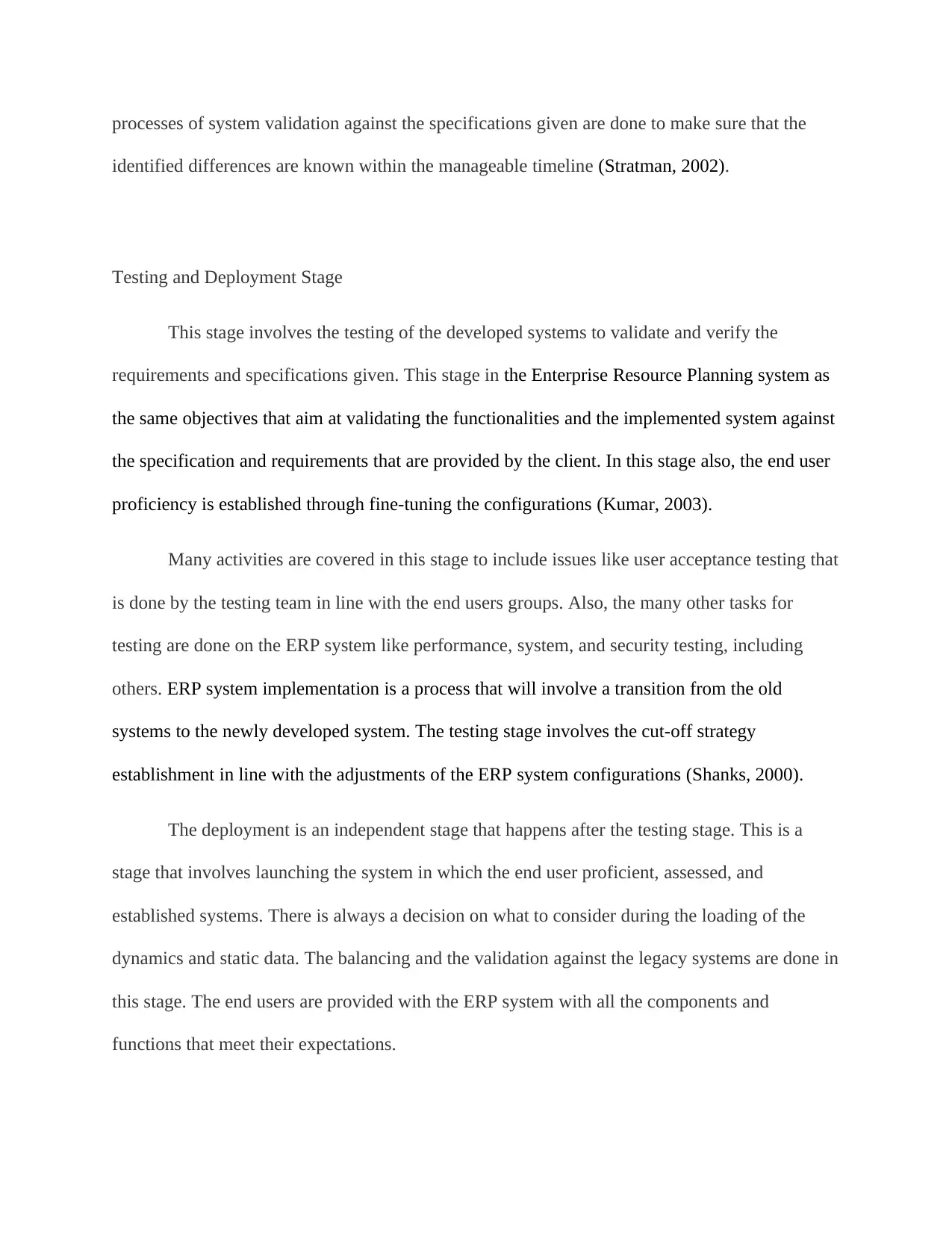
processes of system validation against the specifications given are done to make sure that the
identified differences are known within the manageable timeline (Stratman, 2002).
Testing and Deployment Stage
This stage involves the testing of the developed systems to validate and verify the
requirements and specifications given. This stage in the Enterprise Resource Planning system as
the same objectives that aim at validating the functionalities and the implemented system against
the specification and requirements that are provided by the client. In this stage also, the end user
proficiency is established through fine-tuning the configurations (Kumar, 2003).
Many activities are covered in this stage to include issues like user acceptance testing that
is done by the testing team in line with the end users groups. Also, the many other tasks for
testing are done on the ERP system like performance, system, and security testing, including
others. ERP system implementation is a process that will involve a transition from the old
systems to the newly developed system. The testing stage involves the cut-off strategy
establishment in line with the adjustments of the ERP system configurations (Shanks, 2000).
The deployment is an independent stage that happens after the testing stage. This is a
stage that involves launching the system in which the end user proficient, assessed, and
established systems. There is always a decision on what to consider during the loading of the
dynamics and static data. The balancing and the validation against the legacy systems are done in
this stage. The end users are provided with the ERP system with all the components and
functions that meet their expectations.
identified differences are known within the manageable timeline (Stratman, 2002).
Testing and Deployment Stage
This stage involves the testing of the developed systems to validate and verify the
requirements and specifications given. This stage in the Enterprise Resource Planning system as
the same objectives that aim at validating the functionalities and the implemented system against
the specification and requirements that are provided by the client. In this stage also, the end user
proficiency is established through fine-tuning the configurations (Kumar, 2003).
Many activities are covered in this stage to include issues like user acceptance testing that
is done by the testing team in line with the end users groups. Also, the many other tasks for
testing are done on the ERP system like performance, system, and security testing, including
others. ERP system implementation is a process that will involve a transition from the old
systems to the newly developed system. The testing stage involves the cut-off strategy
establishment in line with the adjustments of the ERP system configurations (Shanks, 2000).
The deployment is an independent stage that happens after the testing stage. This is a
stage that involves launching the system in which the end user proficient, assessed, and
established systems. There is always a decision on what to consider during the loading of the
dynamics and static data. The balancing and the validation against the legacy systems are done in
this stage. The end users are provided with the ERP system with all the components and
functions that meet their expectations.
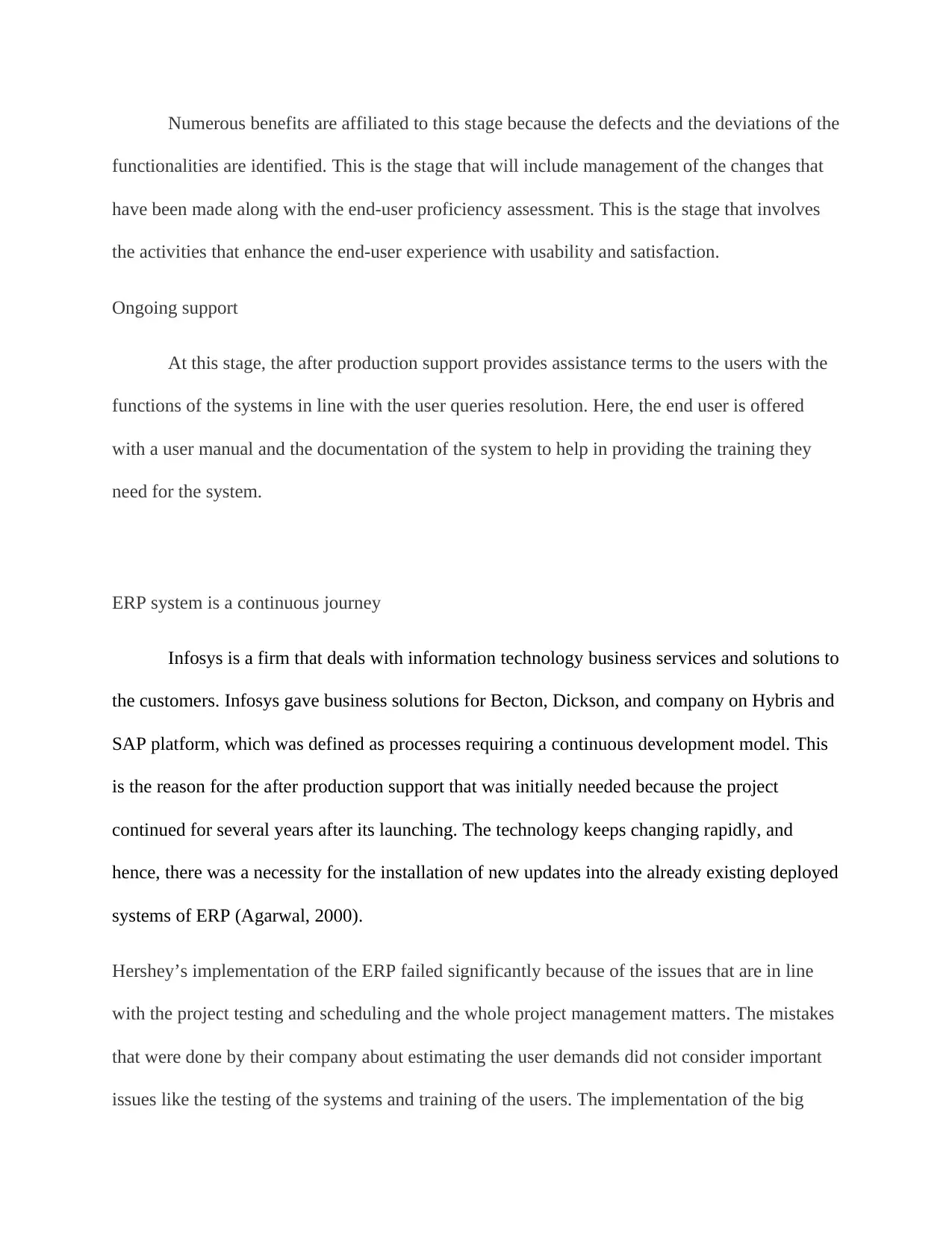
Numerous benefits are affiliated to this stage because the defects and the deviations of the
functionalities are identified. This is the stage that will include management of the changes that
have been made along with the end-user proficiency assessment. This is the stage that involves
the activities that enhance the end-user experience with usability and satisfaction.
Ongoing support
At this stage, the after production support provides assistance terms to the users with the
functions of the systems in line with the user queries resolution. Here, the end user is offered
with a user manual and the documentation of the system to help in providing the training they
need for the system.
ERP system is a continuous journey
Infosys is a firm that deals with information technology business services and solutions to
the customers. Infosys gave business solutions for Becton, Dickson, and company on Hybris and
SAP platform, which was defined as processes requiring a continuous development model. This
is the reason for the after production support that was initially needed because the project
continued for several years after its launching. The technology keeps changing rapidly, and
hence, there was a necessity for the installation of new updates into the already existing deployed
systems of ERP (Agarwal, 2000).
Hershey’s implementation of the ERP failed significantly because of the issues that are in line
with the project testing and scheduling and the whole project management matters. The mistakes
that were done by their company about estimating the user demands did not consider important
issues like the testing of the systems and training of the users. The implementation of the big
functionalities are identified. This is the stage that will include management of the changes that
have been made along with the end-user proficiency assessment. This is the stage that involves
the activities that enhance the end-user experience with usability and satisfaction.
Ongoing support
At this stage, the after production support provides assistance terms to the users with the
functions of the systems in line with the user queries resolution. Here, the end user is offered
with a user manual and the documentation of the system to help in providing the training they
need for the system.
ERP system is a continuous journey
Infosys is a firm that deals with information technology business services and solutions to
the customers. Infosys gave business solutions for Becton, Dickson, and company on Hybris and
SAP platform, which was defined as processes requiring a continuous development model. This
is the reason for the after production support that was initially needed because the project
continued for several years after its launching. The technology keeps changing rapidly, and
hence, there was a necessity for the installation of new updates into the already existing deployed
systems of ERP (Agarwal, 2000).
Hershey’s implementation of the ERP failed significantly because of the issues that are in line
with the project testing and scheduling and the whole project management matters. The mistakes
that were done by their company about estimating the user demands did not consider important
issues like the testing of the systems and training of the users. The implementation of the big
⊘ This is a preview!⊘
Do you want full access?
Subscribe today to unlock all pages.

Trusted by 1+ million students worldwide
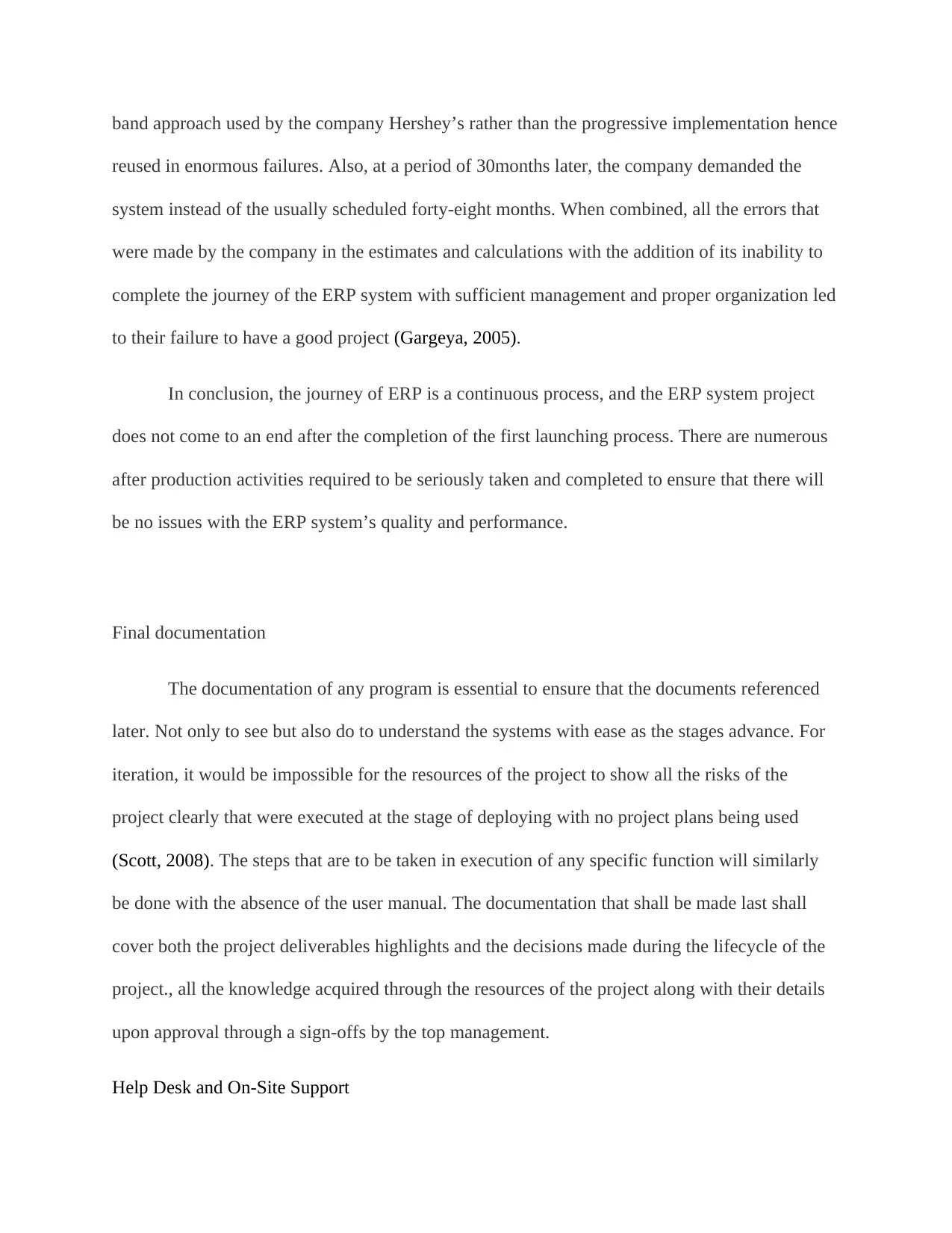
band approach used by the company Hershey’s rather than the progressive implementation hence
reused in enormous failures. Also, at a period of 30months later, the company demanded the
system instead of the usually scheduled forty-eight months. When combined, all the errors that
were made by the company in the estimates and calculations with the addition of its inability to
complete the journey of the ERP system with sufficient management and proper organization led
to their failure to have a good project (Gargeya, 2005).
In conclusion, the journey of ERP is a continuous process, and the ERP system project
does not come to an end after the completion of the first launching process. There are numerous
after production activities required to be seriously taken and completed to ensure that there will
be no issues with the ERP system’s quality and performance.
Final documentation
The documentation of any program is essential to ensure that the documents referenced
later. Not only to see but also do to understand the systems with ease as the stages advance. For
iteration, it would be impossible for the resources of the project to show all the risks of the
project clearly that were executed at the stage of deploying with no project plans being used
(Scott, 2008). The steps that are to be taken in execution of any specific function will similarly
be done with the absence of the user manual. The documentation that shall be made last shall
cover both the project deliverables highlights and the decisions made during the lifecycle of the
project., all the knowledge acquired through the resources of the project along with their details
upon approval through a sign-offs by the top management.
Help Desk and On-Site Support
reused in enormous failures. Also, at a period of 30months later, the company demanded the
system instead of the usually scheduled forty-eight months. When combined, all the errors that
were made by the company in the estimates and calculations with the addition of its inability to
complete the journey of the ERP system with sufficient management and proper organization led
to their failure to have a good project (Gargeya, 2005).
In conclusion, the journey of ERP is a continuous process, and the ERP system project
does not come to an end after the completion of the first launching process. There are numerous
after production activities required to be seriously taken and completed to ensure that there will
be no issues with the ERP system’s quality and performance.
Final documentation
The documentation of any program is essential to ensure that the documents referenced
later. Not only to see but also do to understand the systems with ease as the stages advance. For
iteration, it would be impossible for the resources of the project to show all the risks of the
project clearly that were executed at the stage of deploying with no project plans being used
(Scott, 2008). The steps that are to be taken in execution of any specific function will similarly
be done with the absence of the user manual. The documentation that shall be made last shall
cover both the project deliverables highlights and the decisions made during the lifecycle of the
project., all the knowledge acquired through the resources of the project along with their details
upon approval through a sign-offs by the top management.
Help Desk and On-Site Support
Paraphrase This Document
Need a fresh take? Get an instant paraphrase of this document with our AI Paraphraser
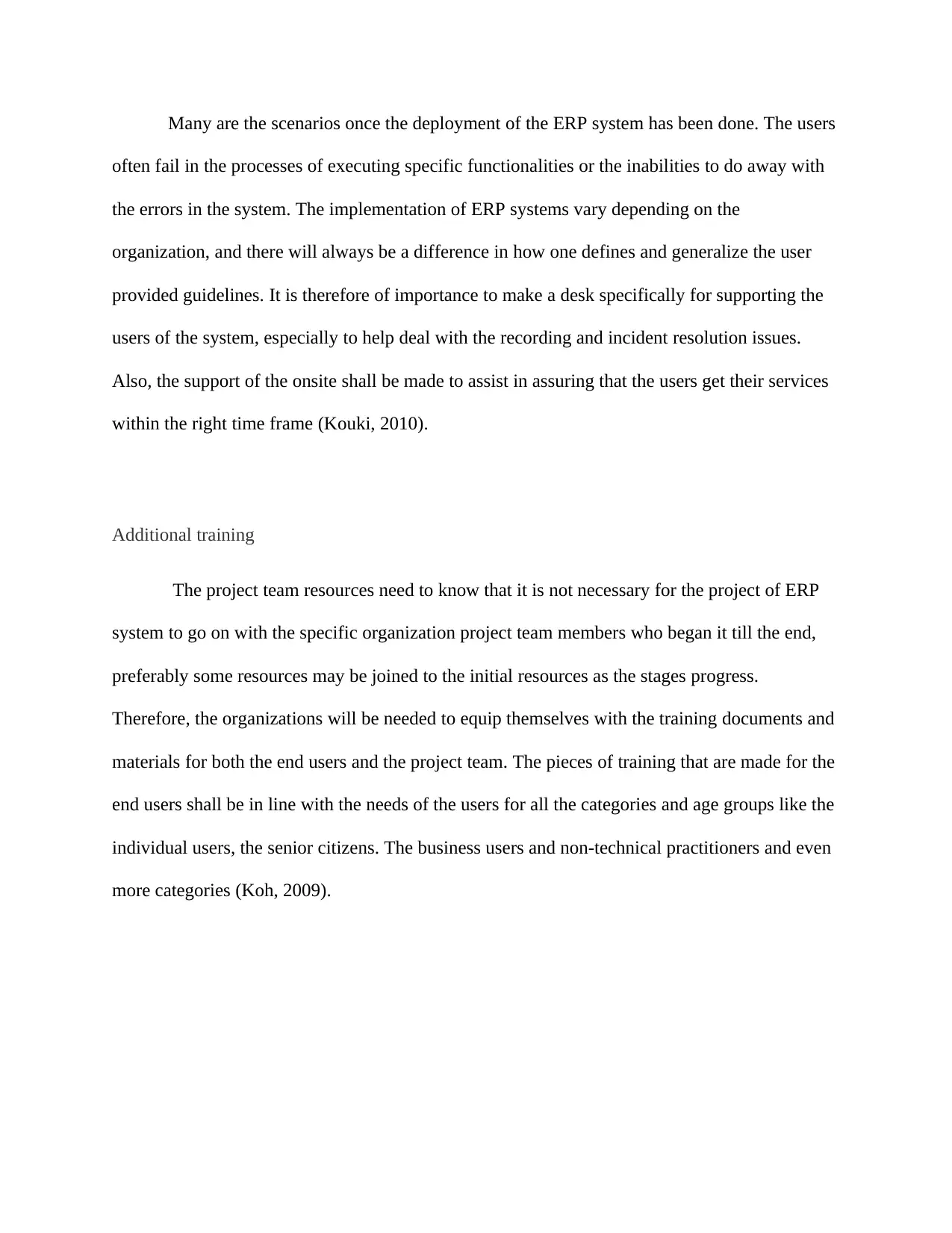
Many are the scenarios once the deployment of the ERP system has been done. The users
often fail in the processes of executing specific functionalities or the inabilities to do away with
the errors in the system. The implementation of ERP systems vary depending on the
organization, and there will always be a difference in how one defines and generalize the user
provided guidelines. It is therefore of importance to make a desk specifically for supporting the
users of the system, especially to help deal with the recording and incident resolution issues.
Also, the support of the onsite shall be made to assist in assuring that the users get their services
within the right time frame (Kouki, 2010).
Additional training
The project team resources need to know that it is not necessary for the project of ERP
system to go on with the specific organization project team members who began it till the end,
preferably some resources may be joined to the initial resources as the stages progress.
Therefore, the organizations will be needed to equip themselves with the training documents and
materials for both the end users and the project team. The pieces of training that are made for the
end users shall be in line with the needs of the users for all the categories and age groups like the
individual users, the senior citizens. The business users and non-technical practitioners and even
more categories (Koh, 2009).
often fail in the processes of executing specific functionalities or the inabilities to do away with
the errors in the system. The implementation of ERP systems vary depending on the
organization, and there will always be a difference in how one defines and generalize the user
provided guidelines. It is therefore of importance to make a desk specifically for supporting the
users of the system, especially to help deal with the recording and incident resolution issues.
Also, the support of the onsite shall be made to assist in assuring that the users get their services
within the right time frame (Kouki, 2010).
Additional training
The project team resources need to know that it is not necessary for the project of ERP
system to go on with the specific organization project team members who began it till the end,
preferably some resources may be joined to the initial resources as the stages progress.
Therefore, the organizations will be needed to equip themselves with the training documents and
materials for both the end users and the project team. The pieces of training that are made for the
end users shall be in line with the needs of the users for all the categories and age groups like the
individual users, the senior citizens. The business users and non-technical practitioners and even
more categories (Koh, 2009).
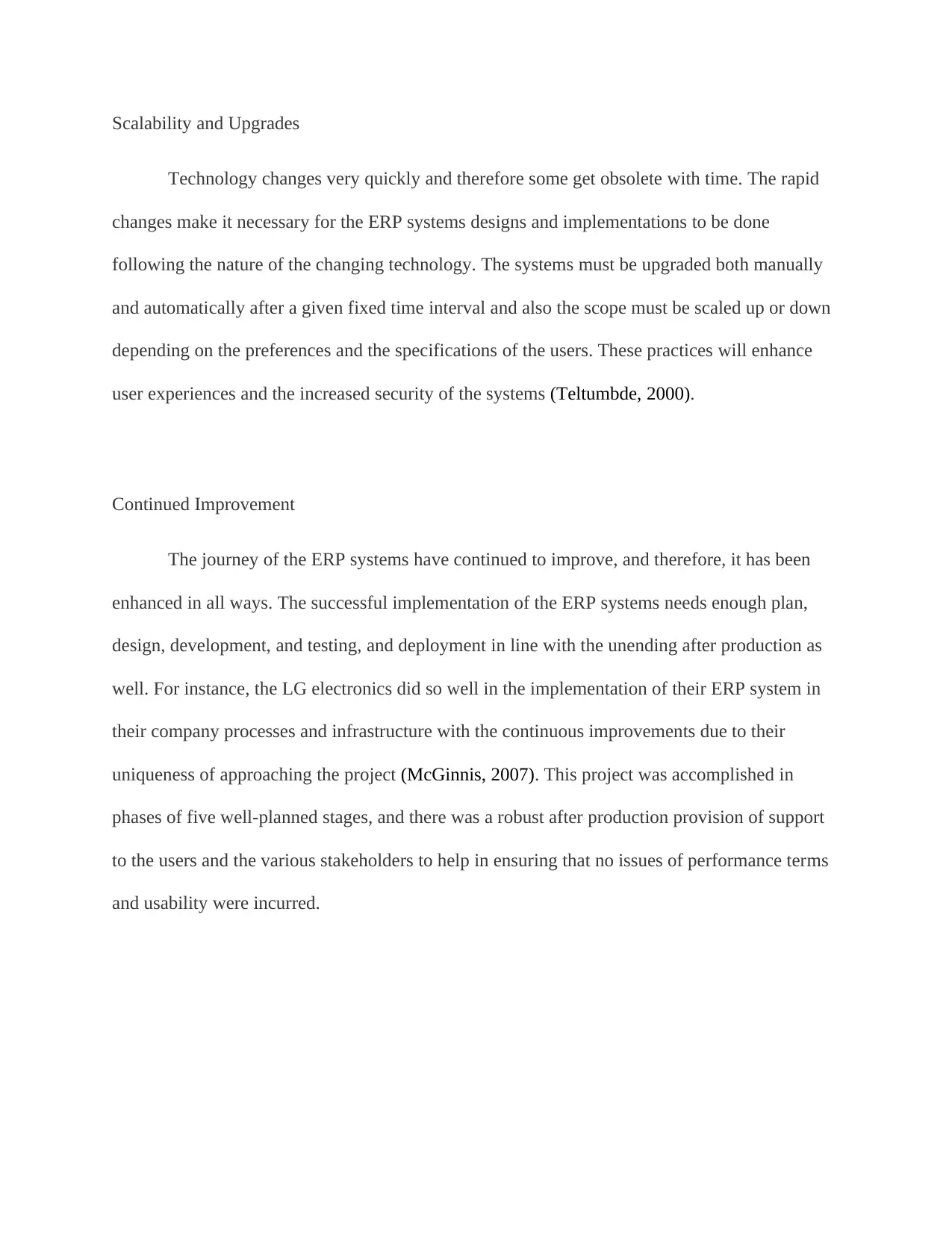
Scalability and Upgrades
Technology changes very quickly and therefore some get obsolete with time. The rapid
changes make it necessary for the ERP systems designs and implementations to be done
following the nature of the changing technology. The systems must be upgraded both manually
and automatically after a given fixed time interval and also the scope must be scaled up or down
depending on the preferences and the specifications of the users. These practices will enhance
user experiences and the increased security of the systems (Teltumbde, 2000).
Continued Improvement
The journey of the ERP systems have continued to improve, and therefore, it has been
enhanced in all ways. The successful implementation of the ERP systems needs enough plan,
design, development, and testing, and deployment in line with the unending after production as
well. For instance, the LG electronics did so well in the implementation of their ERP system in
their company processes and infrastructure with the continuous improvements due to their
uniqueness of approaching the project (McGinnis, 2007). This project was accomplished in
phases of five well-planned stages, and there was a robust after production provision of support
to the users and the various stakeholders to help in ensuring that no issues of performance terms
and usability were incurred.
Technology changes very quickly and therefore some get obsolete with time. The rapid
changes make it necessary for the ERP systems designs and implementations to be done
following the nature of the changing technology. The systems must be upgraded both manually
and automatically after a given fixed time interval and also the scope must be scaled up or down
depending on the preferences and the specifications of the users. These practices will enhance
user experiences and the increased security of the systems (Teltumbde, 2000).
Continued Improvement
The journey of the ERP systems have continued to improve, and therefore, it has been
enhanced in all ways. The successful implementation of the ERP systems needs enough plan,
design, development, and testing, and deployment in line with the unending after production as
well. For instance, the LG electronics did so well in the implementation of their ERP system in
their company processes and infrastructure with the continuous improvements due to their
uniqueness of approaching the project (McGinnis, 2007). This project was accomplished in
phases of five well-planned stages, and there was a robust after production provision of support
to the users and the various stakeholders to help in ensuring that no issues of performance terms
and usability were incurred.
⊘ This is a preview!⊘
Do you want full access?
Subscribe today to unlock all pages.

Trusted by 1+ million students worldwide
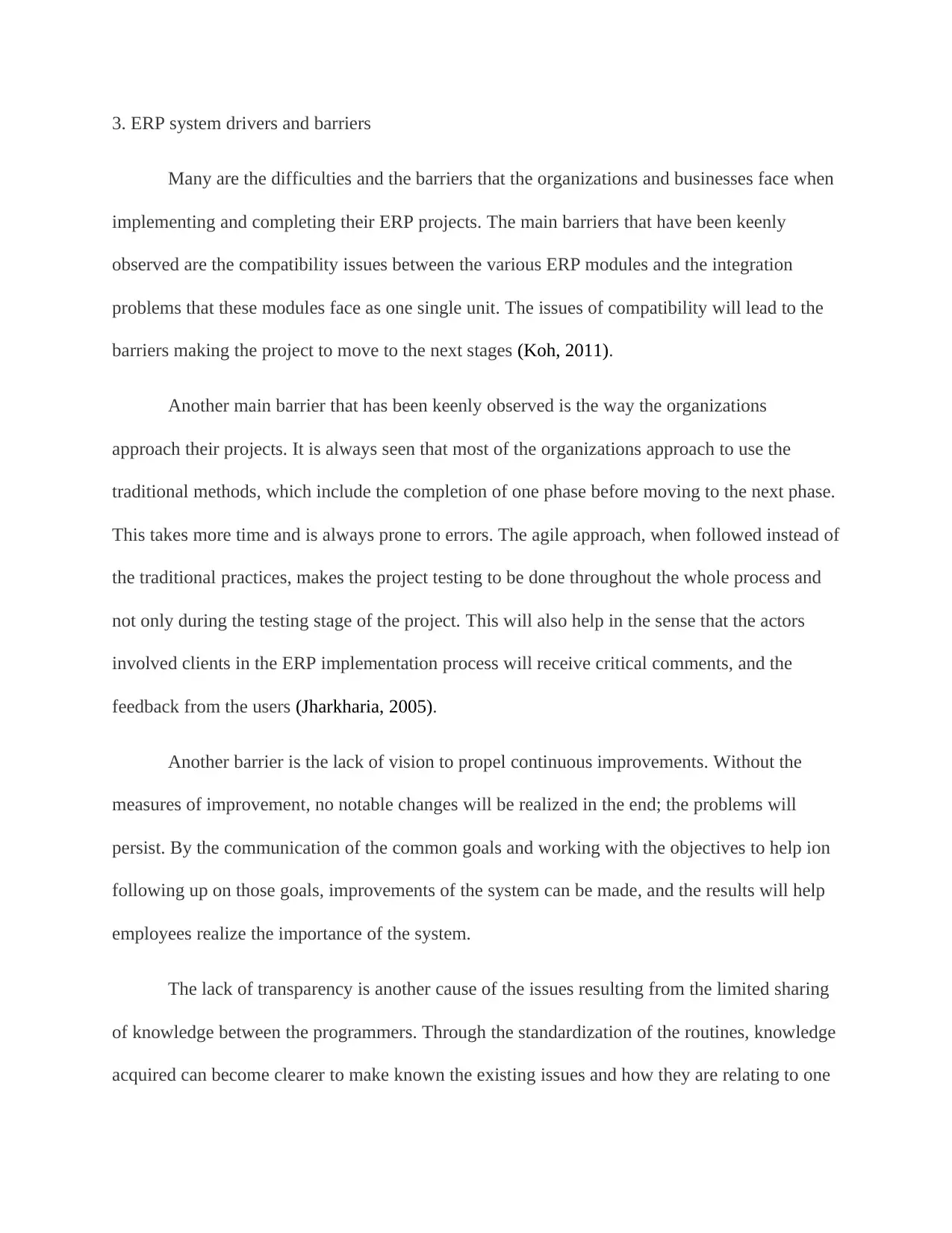
3. ERP system drivers and barriers
Many are the difficulties and the barriers that the organizations and businesses face when
implementing and completing their ERP projects. The main barriers that have been keenly
observed are the compatibility issues between the various ERP modules and the integration
problems that these modules face as one single unit. The issues of compatibility will lead to the
barriers making the project to move to the next stages (Koh, 2011).
Another main barrier that has been keenly observed is the way the organizations
approach their projects. It is always seen that most of the organizations approach to use the
traditional methods, which include the completion of one phase before moving to the next phase.
This takes more time and is always prone to errors. The agile approach, when followed instead of
the traditional practices, makes the project testing to be done throughout the whole process and
not only during the testing stage of the project. This will also help in the sense that the actors
involved clients in the ERP implementation process will receive critical comments, and the
feedback from the users (Jharkharia, 2005).
Another barrier is the lack of vision to propel continuous improvements. Without the
measures of improvement, no notable changes will be realized in the end; the problems will
persist. By the communication of the common goals and working with the objectives to help ion
following up on those goals, improvements of the system can be made, and the results will help
employees realize the importance of the system.
The lack of transparency is another cause of the issues resulting from the limited sharing
of knowledge between the programmers. Through the standardization of the routines, knowledge
acquired can become clearer to make known the existing issues and how they are relating to one
Many are the difficulties and the barriers that the organizations and businesses face when
implementing and completing their ERP projects. The main barriers that have been keenly
observed are the compatibility issues between the various ERP modules and the integration
problems that these modules face as one single unit. The issues of compatibility will lead to the
barriers making the project to move to the next stages (Koh, 2011).
Another main barrier that has been keenly observed is the way the organizations
approach their projects. It is always seen that most of the organizations approach to use the
traditional methods, which include the completion of one phase before moving to the next phase.
This takes more time and is always prone to errors. The agile approach, when followed instead of
the traditional practices, makes the project testing to be done throughout the whole process and
not only during the testing stage of the project. This will also help in the sense that the actors
involved clients in the ERP implementation process will receive critical comments, and the
feedback from the users (Jharkharia, 2005).
Another barrier is the lack of vision to propel continuous improvements. Without the
measures of improvement, no notable changes will be realized in the end; the problems will
persist. By the communication of the common goals and working with the objectives to help ion
following up on those goals, improvements of the system can be made, and the results will help
employees realize the importance of the system.
The lack of transparency is another cause of the issues resulting from the limited sharing
of knowledge between the programmers. Through the standardization of the routines, knowledge
acquired can become clearer to make known the existing issues and how they are relating to one
Paraphrase This Document
Need a fresh take? Get an instant paraphrase of this document with our AI Paraphraser
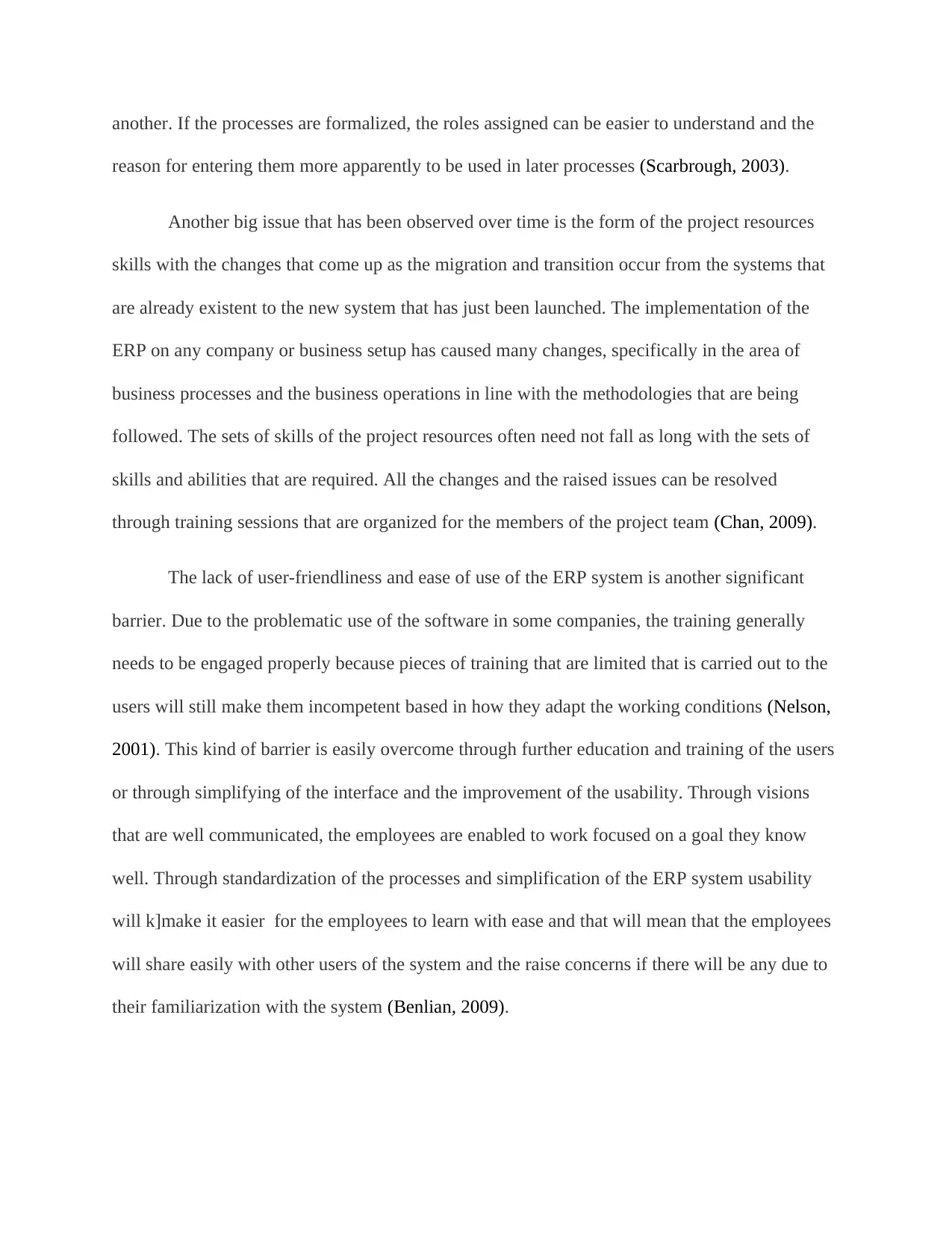
another. If the processes are formalized, the roles assigned can be easier to understand and the
reason for entering them more apparently to be used in later processes (Scarbrough, 2003).
Another big issue that has been observed over time is the form of the project resources
skills with the changes that come up as the migration and transition occur from the systems that
are already existent to the new system that has just been launched. The implementation of the
ERP on any company or business setup has caused many changes, specifically in the area of
business processes and the business operations in line with the methodologies that are being
followed. The sets of skills of the project resources often need not fall as long with the sets of
skills and abilities that are required. All the changes and the raised issues can be resolved
through training sessions that are organized for the members of the project team (Chan, 2009).
The lack of user-friendliness and ease of use of the ERP system is another significant
barrier. Due to the problematic use of the software in some companies, the training generally
needs to be engaged properly because pieces of training that are limited that is carried out to the
users will still make them incompetent based in how they adapt the working conditions (Nelson,
2001). This kind of barrier is easily overcome through further education and training of the users
or through simplifying of the interface and the improvement of the usability. Through visions
that are well communicated, the employees are enabled to work focused on a goal they know
well. Through standardization of the processes and simplification of the ERP system usability
will k]make it easier for the employees to learn with ease and that will mean that the employees
will share easily with other users of the system and the raise concerns if there will be any due to
their familiarization with the system (Benlian, 2009).
reason for entering them more apparently to be used in later processes (Scarbrough, 2003).
Another big issue that has been observed over time is the form of the project resources
skills with the changes that come up as the migration and transition occur from the systems that
are already existent to the new system that has just been launched. The implementation of the
ERP on any company or business setup has caused many changes, specifically in the area of
business processes and the business operations in line with the methodologies that are being
followed. The sets of skills of the project resources often need not fall as long with the sets of
skills and abilities that are required. All the changes and the raised issues can be resolved
through training sessions that are organized for the members of the project team (Chan, 2009).
The lack of user-friendliness and ease of use of the ERP system is another significant
barrier. Due to the problematic use of the software in some companies, the training generally
needs to be engaged properly because pieces of training that are limited that is carried out to the
users will still make them incompetent based in how they adapt the working conditions (Nelson,
2001). This kind of barrier is easily overcome through further education and training of the users
or through simplifying of the interface and the improvement of the usability. Through visions
that are well communicated, the employees are enabled to work focused on a goal they know
well. Through standardization of the processes and simplification of the ERP system usability
will k]make it easier for the employees to learn with ease and that will mean that the employees
will share easily with other users of the system and the raise concerns if there will be any due to
their familiarization with the system (Benlian, 2009).
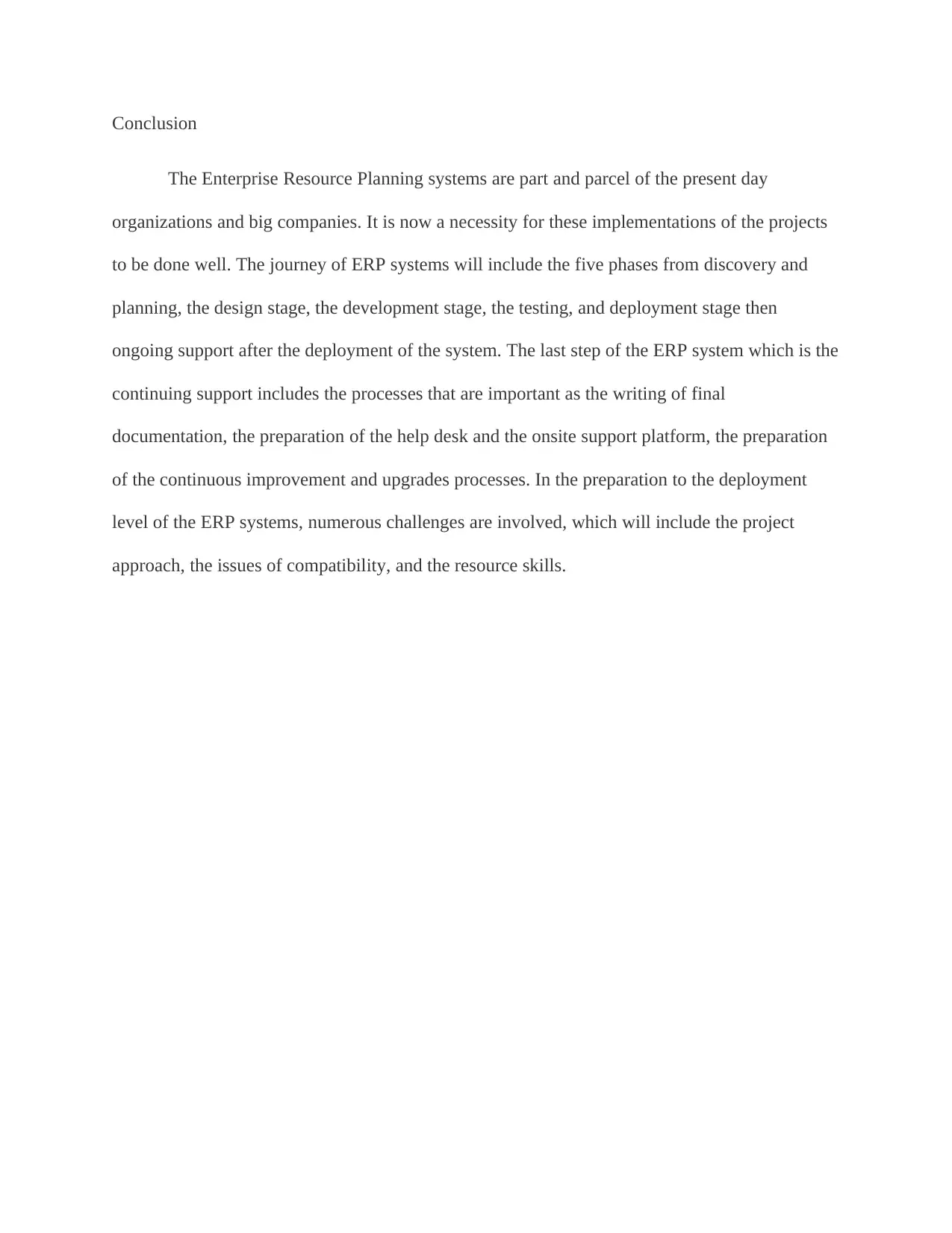
Conclusion
The Enterprise Resource Planning systems are part and parcel of the present day
organizations and big companies. It is now a necessity for these implementations of the projects
to be done well. The journey of ERP systems will include the five phases from discovery and
planning, the design stage, the development stage, the testing, and deployment stage then
ongoing support after the deployment of the system. The last step of the ERP system which is the
continuing support includes the processes that are important as the writing of final
documentation, the preparation of the help desk and the onsite support platform, the preparation
of the continuous improvement and upgrades processes. In the preparation to the deployment
level of the ERP systems, numerous challenges are involved, which will include the project
approach, the issues of compatibility, and the resource skills.
The Enterprise Resource Planning systems are part and parcel of the present day
organizations and big companies. It is now a necessity for these implementations of the projects
to be done well. The journey of ERP systems will include the five phases from discovery and
planning, the design stage, the development stage, the testing, and deployment stage then
ongoing support after the deployment of the system. The last step of the ERP system which is the
continuing support includes the processes that are important as the writing of final
documentation, the preparation of the help desk and the onsite support platform, the preparation
of the continuous improvement and upgrades processes. In the preparation to the deployment
level of the ERP systems, numerous challenges are involved, which will include the project
approach, the issues of compatibility, and the resource skills.
⊘ This is a preview!⊘
Do you want full access?
Subscribe today to unlock all pages.

Trusted by 1+ million students worldwide
1 out of 14
Related Documents
Your All-in-One AI-Powered Toolkit for Academic Success.
+13062052269
info@desklib.com
Available 24*7 on WhatsApp / Email
![[object Object]](/_next/static/media/star-bottom.7253800d.svg)
Unlock your academic potential
Copyright © 2020–2025 A2Z Services. All Rights Reserved. Developed and managed by ZUCOL.





